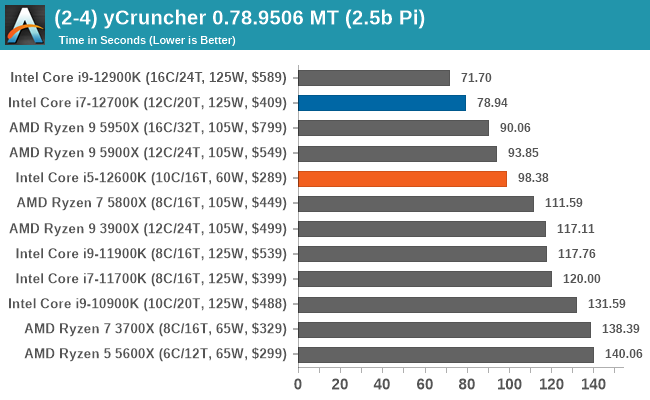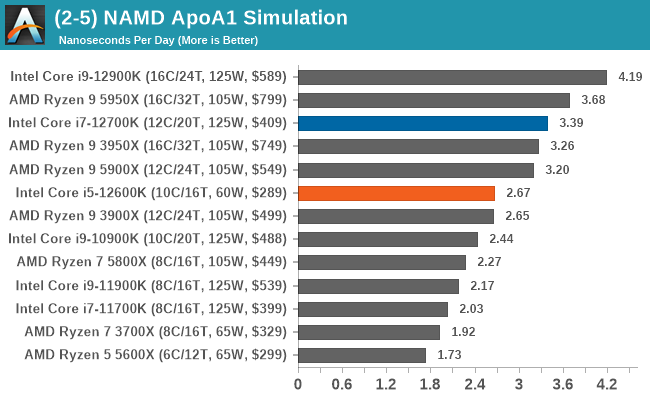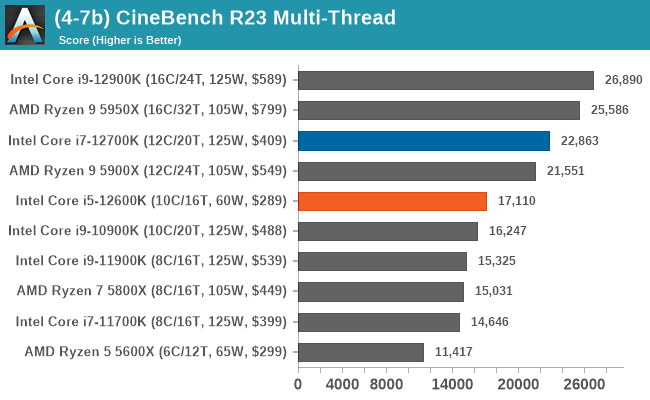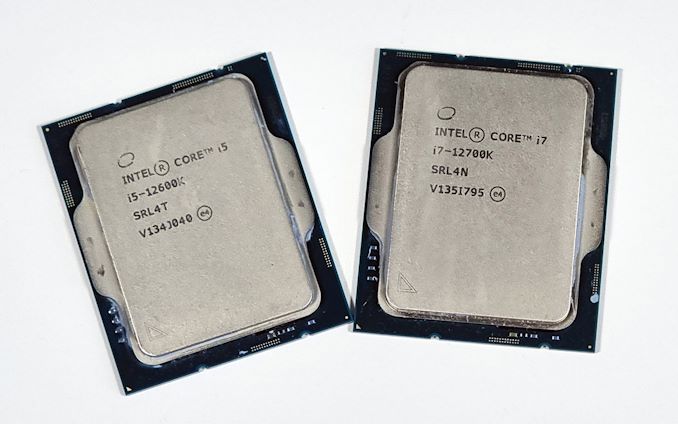The Intel Core i7-12700K and Core i5-12600K Review: High Performance For the Mid-Range
by Gavin Bonshor on March 29, 2022 8:00 AM ESTConclusion
As we make good headway into 2022 and beyond, the dynamic of the CPU market is constantly changing and evolving. What was once for many years a war based on core count on chips between Intel and AMD has now become a battle of whose core performs more efficiently, is faster, and offers better value. It's no surprise that both of Intel and AMD's flagship offerings (Core i9-12900K versus Ryzen 9 5950X) have been one based on everything but value; both companies have respectively changed the desktop processor market for the better.
In what is possibly our final look at Intel's 12th Gen Core series processors, I feel that it has been a successful launch for one main reason. This all comes down to value, as 12th Gen Alder Lake has been one of the first Core series since AMD launched its Zen architecture back in 2017 to offer users something that feels like good value for the price, compared to what it has done in the past. Not only that, but Intel has bridged the gap between themselves and AMD with improved IPC performance, which leapfrogs AMD's Zen 3 architecture. Another element is in multi-threaded applications. The increased IPC with the Golden Cove P-Cores combined with its Gracemont E-Cores helps negate some of AMD's Ryzen 5000 series previous dominance in certain situations where higher core counts are favored.
The 12-Core to 8-Core Desktop Processor Market: Alder Lake Makes a Splash
While it has been noted by several outlets and retailers over the last month, AMD has finally cut the pricing on its Ryzen 5000 series desktop processors. This doesn't just feel like a ploy from AMD to increase competitiveness against Intel's 12th Gen Core offerings. Still, it's notable that it's taken AMD this long to catch up with demand for their chips. It underscores how everything below high-end/flagship CPUs has been rather underserved for the last year and a half, as chip shortages have sent resources elsewhere.
Turning back to now, and as it stands, Intel's Alder Lake offers more in terms of performance for the price, especially in the sub $450 processor market.
| Intel Versus AMD Mid-Range Price Comparison (as of 03/20) | ||||||
| Intel Core 12th Gen |
Cores | Price ($) |
Price ($) |
Cores | AMD Ryzen 5000 |
|
| Core i7-12700K | 8+4 (12) | $385 | vs. | $485 | 12C | Ryzen 9 5900X |
| Core i5-12600K | 6+4 (10) | $279 | vs. | $390 | 8C | Ryzen 7 5800X |
As well as AMD's recent price drops on its Ryzen 5000 offerings, we've been noticing small and subtle price drops on Intel's 12th Gen Core series too. This means that despite the Ryzen 9 5900X, which is currently on sale for $485 at Amazon, is undoubtedly a better price than it was ($570), the Intel Core i7-12700K is now available at the lower cost of $385 at Amazon. Intel's offering better value and is around 20% cheaper when comparing both chips at Amazon; other retailers may vary.
Looking at the differentials in the other battle between the Core i5-12600K and Ryzen 7 5800X, the same can also be applied. The Ryzen 7 5800X, which now costs $390 at Amazon, is down from $450. In contrast, the Core i5-12600K is available for $280 at Amazon, which means Intel is around 20% cheaper on its 10-core 12th Gen series chip.
It's worth noting that due to AMD's Zen 3 chiplet design, its Core Chiplet Die (CCD) is limited to 1 x CCD of 6-cores and 8-cores at the moment, meaning an actual 10-core competitor to the Core i5-12600K isn't viable, at least from a cost and yield standpoint. AMD could release a 10-core Ryzen 5000 processor if it disabled cores on one of the CCDs, but this again wouldn't be viable from AMD's perspective.
Intel is currently winning the pricing war when it comes to the value proposition in both the respective markets (12C and 10/8C). This can and would only change if AMD decided to cut its pricing even further, though at this point the deciding factor doesn't seem to be Alder Lake's performance, but rather how much of AMD's 7nm wafer allocation is being consumed by higher margin products like EPYC chips. Make no mistake, Intel's mid-range and enthusiast class Alder Lake chips are legitimately good, but there's also an element of "winner by default" at play due to AMD's seemingly limited chip volumes in these segments.
Core i7-12700K and Core i5-12600K Performance Analysis:
Focusing on the performance of both the Core i7-12700K and Core i5-12600K, both processors are competitive and have viable trade-offs against the competition. For the purposes of acknowledgment, we've included both the Core i9-12900K and Ryzen 9 5950X into our data arc for this review. This allows us to better judge the propositions of value and competition throughout Intel's Alder Lake offerings and AMD's Ryzen 5000 desktop chips.

Taking a look at some benchmarks that reasonably conclude the landscape of the desktop market, our science-based yCruncher benchmark shows the natural levels of performance when comparing Alder Lake to Zen 3. In this test, the Alder Lake-based 12th Gen Core processors outperform each of their market rivals. The Core i5-12600K sits between both the Ryzen 9 5900X and the Ryzen 7 5800X here, which is relative to the core count and the difference in IPC performance between both architectures.

In another science-focused benchmark, both the Core i7-12700K and Core i5-12600K perform well in respect to the competition. The NAMD ApoA1 simulation benchmark favors a mixture of core/thread count, with faster cores at equal core counts proving more effective.

The popular Cinebench R23 benchmark is used often by manufacturers and media alike to show off rendering performance across the single and multi-threaded performance. We already know that Alder Lake has an IPC advantage over Zen 3, as seen in our previous Core i9-12900K and Core i3-12300 reviews, so we're focusing on multi-threaded performance here.
Both the Core i7-12700K and Core i5-12600K perform well in the Cinebench R23 Multi-Thread test, and while it's notable that the flagship Core i9-12900K reigns supreme, the Core i7-12700K isn't too far behind the Ryzen 9 5950X, which is exceptional.
While it is fair to say that the use of DDR5 memory on Alder Lake is definitely a contributing factor to some of the extra performance gains, it's fair to judge performance based on the achievable performance using the best technologies available. Overall, the Core i7-12700K is perhaps the best sub $400 processor from a price to performance point of view, and this is confirmed throughout our testing. In contrast, using Windows 11 over Windows 10 yields little gain, and we also test with memory settings based on what the chip is capable of based on JEDEC settings.

The recent offerings from both Intel and AMD perform well in gaming, with much of the variation in performance surrounding what each of the game developer's titles is aligned with. This means that game titles that partner with Intel generally performs better due to code and integrated technologies. At the same time, AMD has the same thing with the developers it partners with. The overall situation in gaming performance is quite simple; all of the 8C+ processors from both team Intel (Alder Lake) and team AMD (Zen 3) all perform well, with slight nuances based on the game developer's level of its multi-threaded application being another contributing factor to performance.
Summary
Selecting a processor to build a new system or upgrade an existing one, both Intel and AMD have plenty of options for users to sink their teeth into. There's something for everyone when it comes to selecting the best processor for the task at hand, be that rendering, a workstation, a gaming system, or even just for web-browsing.
Getting straight to the point on our opinion of Intel's 12th Gen Core i7-12700K and Core i5-12600K processors, both perform very well and are the best all-round performers at their respective price points. When it comes to selecting a processor between $250 and $450 for a gaming system, it makes very little sense than to opt for the Core i5-12600K, as it has a good balance of cores (10C/16T) with enough performance on those cores to make it a no brainer for $279.

The Intel Core i5-12600K (left) and Core i7-12700K (right) processors.
The extra money saved opting for the Core i5-12600K over the Core i7-12700K could be put towards a better video card, which would offer a more significant jump in frame rates over opting for the more expensive processor. It's clear that the Core i7-12700K and Core i5-12600K are a better buy, both from a value and performance perspective over the competing AMD Ryzen 5000 series processors.
Overall, Intel's Alder Lake architecture is an important win for the company that has consistently lost desktop processor market share since Zen debuted back in 2017. Even with the launch of AMD's Ryzen 7 5800X3D, due on April 20th, it's more likely to be competitive with the Core i7-12700K in gaming, and if its 96 MB of 3D V-Cache is as effective in gaming as AMD suggests, it could be neck and neck there. However, the Core i7-12700K benefits from an unlocked multiplier, and system tweakers are more likely to get a better price to performance ratio with Intel.
Right now, Alder Lake has the competitive advantage over Zen 3, and that's to be expected, as this is the second attempt from Intel to close the gap between itself and AMD's Ryzen 5000 lineup. The biggest question is, what's on the horizon? We know AMD is planning to release its Zen 4 5 nm based processors sometime this year, and the generational gap between Zen 2 and Zen 3 was very impressive. It still remains to be seen how that pans out, but for now, Intel's 12th Gen Core series is certainly worthy of consideration, especially with its more aggressive pricing.










196 Comments
View All Comments
ballsystemlord - Saturday, April 2, 2022 - link
Not being a financial guy, I'm just a bit lost here. Please clarify. I will try to explain what I don't understand.Intel gives a rebate for using their CPUs in designs, but only if the OEMs sell them? Then the retailers also get a rebate on the sale of the product?
Intel doubles production of CPUs every year. How do they get rid of them all? If that was working, why did they switch to demand based production for Ice and Alder Lake?
Thanks!
Qasar - Sunday, April 3, 2022 - link
ballsystemlord, wow, you actually read all of that ? i started to, but the more i read, the more it sounded like it was all just made up babble. i have asked him to post sources for his " info " but never does, just posts a link to his OWN site, which, also has NO links to sources. some of his posts, sound like he was drunk when he typed them.mode_13h - Sunday, April 3, 2022 - link
I'm not really sure what to make of it. I treat it mostly as noise, unless/until someone who seems to know their stuff can either challenge or vouch for it.My biggest concern is that these posts are really just a sophisticated form of stock price manipulation, but that's not a claim I'm ready to make. I feels pretty unpleasant when the news comments are used to further someone's agenda, so I hope that's not what this is about.
Qasar - Sunday, April 3, 2022 - link
considering what his posts contain most of the time, and the fact the only link he posts, is to his own page, to me, thats exactly what it is, nothing more. he is trying to promote himself, and how he puts " Mike Bruzzone, Camp Marketing " at the end, kind of proves that.which is why most of the time, i just skip over his posts. its just spam and bs.
Mike Bruzzone - Sunday, April 3, 2022 - link
@mode_13th Think of it as industry and business news most media won't touch for fear of retaliation. Over 30 years denials of access to Intel, to Intel processors, industry boycott, individual blacklist, Intel and agents targeting competitors to destroy economically.Since 1991 there are only three x86 original survivors; me, AMD and Nvidia. I make no money from this task cultivating awareness and understating of primarily the open commerce issues. Nor am I a fan of many Intel invented realities.
I am not paid in my auditor monitor role. The assignment only pays when Intel Inside price fix is recovered on my USDOJ contract that pays a percentage of the Intel Inside federal procurement price fix over charge only. Why I represent 27 States as well, and could collect bounties from States on their Intel Inside citizen specific recoveries, I have waived States bounty on our constituent pact to successfully recover Intel Inside for return to all end buyers. A cartel sales administration cost for registered metering reports to Intel. Think of it as a clandestine tax, illegally robbed at Sherman Act 15 USC 1 by an Intel contracted combine at15 USC 2 intent on conduct to monopolize, Intel false certifications and sales contracts specific Intel Inside requirement prove the case. Then at 18 USC 1962c which is the State AG claim routing processors sold in box and integrated into computers across State lines for what is essentially a clandestine consumer toll way charge. In this example it's called a route fee charge. That charge is again the cost of metering Intel processor sales flow paid by the end buyer in Intel processor price. In the 18 USC 1962c example for exclusive dealing that crosses state lines. Mail fraud is a related example when relied to ship OEM direct PC purchases to the buyer and that OEM cashes in on the Intel Inside route charge cost to the end buyer paid by Intel. mb
Mike Bruzzone - Sunday, April 3, 2022 - link
@Qasar, I've mentioned I am the source. I am the data scientist, the production economist on raw data, the industrial management scientist, general systems technician just like any other analyst who assesses raw data to determine a greater result. I do all my own data collection for the most part it's primary research. I have no secondary source to point too, unless for example the data is from annual or quarterly 10K/Q. My work is mostly from raw data. I am the source of that data's interpretation. I've mentioned much of the data is eBay seller data; unduplicated offers, which is what AMD, Intel and Nvidia rely in house to do the exact same job I do but in my case for the Federal Trade Commission; production economics and supply chain management. But with a twist, that is posting the data and my analysis publicly for government transparency specific FTC v Intel 15 USC 5 Docket 9341. I am a federal attorney enlisted, in an academic role I recommend to no one, Docket 9341 consent order auditor monitor; AMD, Intel, Nvidia, VIA and also includes Arm in relation x86 specifically. mbQasar - Sunday, April 3, 2022 - link
" @Qasar, I've mentioned I am the source " ahh, so in other words, you pull these number and info out of your butt, and it is completely made up. got it. with out legitimate sources, and links to those sources, all of your posts are just fluff, and BS... good thing i skip over most of your posts then.Mike Bruzzone - Tuesday, April 5, 2022 - link
@Qasar, maybe I should put u to work on this as virtual resource to "see this is not fluff", how much time do u have [?], see my SA comment and blog post string and let me know what u r interested in, totally a citizen assignment of course. mbQasar - Wednesday, April 6, 2022 - link
sorry mike, but your posts are fluff, once you post sources to where you get your info from, then they might not be. but till then, they look like they are made up with random info, and posting your own site as a source, is not a source.Mike Bruzzone - Wednesday, April 6, 2022 - link
Quasar, fluff? then is Jon Peddie Research a source, Mercury Research, IDC, Gartner, Canalysis none can show their data or work. I'm the only one who shows my data and proof of work.My data is from ebay, seller offers, I do the same job people ldo inside AMD, Intel and Nvidia keeping track of channel supply volume that can be directly applied to micro production economic assessment and is used by AMD, Intel, Nvidia primarily for channel sales management.
If my site is not a source then, from your perspective, neither is JPR, Mercury, IDC, Gartner, Canalysis, Micro Design Resources, published of Microprocessor Report, not a source?
Sorry to joust with you. Please define source?
Regards, mb